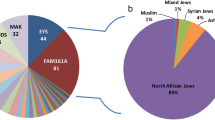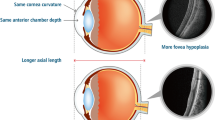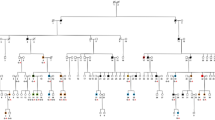Abstract
Purpose
To show the variable expressivity of ocular associations of foveal hypoplasia in three affected members of a family.
Methods
Three symptomatic members of a family underwent a detailed ophthalmic evaluation including best-corrected distance and near-vision measurement, colour vision assessment, fundus evaluation and fluorescein angiography, horizontal corneal diameter measurement, total axial length measurement, and full-field electroretinogram. Optical coherence tomography was performed in two of the three cases. Pedigree charting was also carried out.
Results
Foveal hypoplasia was shown in all three cases. Pedigree charting showed an autosomal recessive (AR) inheritance pattern of foveal hypoplasia in our series. Microphthalmos and chorioretinal coloboma were found to be variably associated with foveal hypoplasia in this series.
Conclusions
This interesting case series shows that variable expressivity could be found in AR inheritance patterns of foveal hypoplasia.
Similar content being viewed by others
Introduction
Foveal hypoplasia has been described in isolation as well as in association with other anatomical eye disorders such as aniridia, albinism, microphthalmos, presenile cataracts, peripheral retinal rosettes, and achromatopsia.1, 2, 3, 4, 5 It is also described as part of Gillespie's syndrome, Aland disease, Hermansky–Pudlak syndrome, and Wolf–Hirschhorn syndrome. This report shows the variable expressivity of ocular associations of foveal hypoplasia in affected members of the same family.
Case 1
A 40-year-old man presented for evaluation of poor vision in both eyes. He gave a history of inward deviation of eyes since childhood. He was born to consanguineous parents and gave a positive family history for nystagmus and poor vision (Figure 1). He was born at term and was otherwise systemically healthy, with no signs of cutaneous albinism. On evaluation, he had high hypermetropia of +11.0 DSph and +10.0 DSph in the right and left eyes, respectively. The best corrected visual acuity (BCVA) for distance and near was 6/60 and N10, respectively, in both eyes. Colour vision assessed by Hardy–Rand–Rittler charts was normal. He had an alternating esotropia of 80 Prism Dioptre (PD) with horizontal pendular nystagmus. The horizontal corneal diameter was 11 mm in both eyes and the anterior segment evaluation was unremarkable. His fundus evaluation showed a poorly defined foveal zone in both eyes and a large typical inferior chorioretinal coloboma in the right eye (Figure 2). The total axial length (TAL) was 18.75 and 18.52 mm in the right and left eyes, respectively. The fundus fluorescein angiogram (FFA) (Topcon TRC 50EX, Tokyo, Japan) showed the absence of foveal avascular zone (FAZ) in both eyes (Figure 3). A full-field electroretinogram (ERG) (Metrovision, Pérenchies, France) showed normal responses in the left eye and reduced amplitude responses in the right eye. The subnormal ERG amplitude obtained from the right eye was attributed to the presence of uveal coloboma in that eye. A diagnosis of foveal hypoplasia with associated microphthalmos and right retinochoroidal coloboma was made.
Pedigree charting of the family. Pedigree of a five-generation family associated with foveal hypoplasia showing autosomal recessive (pseudo dominant) inheritance. The Fully shaded symbol (• → ) indicates affected members who have been completely evaluated. The partially shaded symbol ( → ) indicates members who are affected by symptoms of esotropia, poor vision, and nystagmus. ERG, FFA, and OCT were not performed in these subjects.
→ ) indicates members who are affected by symptoms of esotropia, poor vision, and nystagmus. ERG, FFA, and OCT were not performed in these subjects.
Fundus photographs of the three cases. (a) and (b) are the fundus photographs of the right and left eyes, respectively, of case 1. Note the poorly defined foveal zone in both eyes and the large typically inferior chorioretinal coloboma in the right eye. (c) and (d) are the fundus photographs of the right and left eyes, respectively, of case 2. The foveal zone is poorly defined in both eyes. (e) and (f) are the fundus photographs of the right and left eyes, respectively, of case 3. In addition to the poorly developed foveal zone, also note the extortion of the fundus owing to the overaction of the inferior oblique muscle.
Fundus fluorescein angiogram (FFA) in the three cases showing the absence of foveal avascular zone (FAZ) in all of them. (a) and (b) are FFAs of the right and left eyes, respectively, of case 1. In addition to the absence of FAZ, note the large uveal coloboma in the right eye. (c) and (d) are FFAs of the right and left eyes, respectively, of case 2. (e) and (f) are FFAs of the right and left eyes, respectively, of case 3.
Case 2
The 9-year-old daughter of case 1, with similar symptoms, was found to be high hypermetrope, accepting a correction of +8.5 DSph/−2.00 DCyl × 160° and +7.50 DSph/−1.25 DCyl × 20° in the right and left eyes, respectively. The BCVA for distance and near was 6/30 and N8, respectively, in both eyes. She had an alternating esotropia of 60 PD with pendular nystagmus. Colour vision was normal. The horizontal corneal diameter was 11 mm in both eyes. The TAL was 19.49 and 19.53 mm in the right and left eyes, respectively. The fundus was unremarkable except for absent foveal reflexes in both eyes (Figure 2). FFA confirmed the absence of FAZ (Figure 3). Optical coherence tomography (OCT) (Ophthalmic Technologies Inc., Ontario, Canada) showed the absence of foveal pits in both eyes, and the ERG was normal. A diagnosis of foveal hypoplasia with associated microphthalmos was made.
Case 3
The 6-year-old younger daughter of case 1 also had similar complaints. She accepted a correction of +7.0 DSph/−2.75 DCyl × 10° and +6.5 DSph/−2.0 DCyl × 180° in the right and left eyes, respectively. Her BCVA for distance and near was 6/30 and N8, respectively, in both eyes. She had an alternating esotropia of 60 PD, bilateral grade 3 inferior oblique over action, and pendular nystagmus. Her colour vision was normal and the horizontal corneal diameter was 11 mm in both eyes. The TAL was 20.70 and 20.54 mm in the right and left eyes, respectively. The fundus was unremarkable except for an absent foveal reflex (Figure 2). The FFA confirmed the absence of FAZ (Figure 3), whereas the OCT showed absence of a foveal pit and the ERG was normal. A diagnosis of isolated foveal hypoplasia was made.
Discussion
Foveal hypoplasia is used clinically to describe maculae where the foveal pit is poorly demarcated, with absence of the FAZ implying the lack of centrally specialized structures needed for good visual acuity. OCT in foveal hypoplasia shows the lack of a foveal pit, which is replaced by the central lengthening of the cone's outer segments and widening of the outer nuclear layer in some cases.6 Fovea plana is a term recently suggested to denote only the anatomic lack of a foveal pit6 with no functional implications.
Isolated foveal hypoplasia is suggested to have autosomal recessive (AR) inheritance4 and is the only common feature in all three cases. Foveal hypoplasia with or without ocular associations has also been described.7, 8, 9 Microphthalmos by definition is an eye that has an axial length that is 2 SDs smaller than what is normally expected at that age. This equates to 19.2 mm at 1 year and 20.9 mm at adulthood.10, 11 In this series, microphthalmos without the accompanying microcornea was present in two cases.10, 12 The pedigree chart (Figure 1) shows AR inheritance. The highlight of this series is the variable expressivity of ocular associations in foveal hypoplasia in AR inheritance pattern in the same family, which has not been reported earlier. This suggests that AR foveal hypoplasia may express as an isolated entity or be associated with varied developmental ocular abnormalities. Although uveal coloboma is a known association in microphthalmos,13 this is the first report of chorioretinal coloboma as an association of foveal hypoplasia.
Foveal hypoplasia, microphthalmos, and retinochoroidal coloboma occur because of defects in embryogenesis at various stages of development of the fetus14 owing to defective gene expression. This is an interesting case series of an AR family with foveal hypoplasia.
References
Francois J . Heredity in Ophthalmology. 1961; 153: 519.
Duke-Elder S . System of Ophthalmology. 1963; 3 (2): 652–653.
Waardenburg PJ . Genetics and ophthalmology. 1963; 2: 1722–1723.
Curran RE, Robb RM . Isolated foveal hypoplasia. Arch Ophthalmol 1976; 94 (1): 48–50.
O’Donnell Jr FF, Pappas HR . Autosomal dominant foveal hypoplasia and presenile cataracts. Arch Ophthalmol 1982; 100 (2): 279–281.
Marmor MF, Choi SS, Zawadzki RJ, Werner JS . Visual insignificance of the foveal pit. Reassessment of foveal hypoplasia as fovea plana. Arch Ophthalmol 2008; 126 (7): 907–913.
Azuma N, Nishina S, Yanagisawa H, Okuyama T, Yamada M . PAX6 missense mutation in isolated foveal hypoplasia. Nat Genet 1996; 13: 141–142.
Azuma N, Yamaguchi Y, Handa H, Hayakawa M, Kanai A, Yamada M . Missense mutation in the alternative splice region of the PAX6 gene in eye anomalies. Am J Hum Genet 1999; 65: 656–663.
Pal B, Mohamed MD, Keen TJ, Williams GA, Bradbury JA, Sheridan E et al. A new phenotype of recessively inherited foveal hypoplasia and anterior segment dysgenesis maps to a locus on chromosome 16q23.2-24.2. J Med Genet 2004; 41: 772–777.
Elder MJ . Aetiology of severe visual impairment and blindness in microphthalmos. Br J Ophthalmol 1994; 78: 332–334.
Weiss AH, Kouseff BG, Ross EA, Longbottom J . Simple microphthalmos. Arch Ophthalmol 1989; 107: 1625–1630.
Larsen JS . The sagittal growth of the eye. IV. Ultrasonic measurement of the axial length of the eye from birth to puberty. Acta Ophthalmol (Copenh) 1971; 49 (6): 873–886.
Warburg M . Classification of microphthalmos and coloboma. J Med Genet 1993; 30: 664–669.
Taylor D, Hoyt CS . Pediatric Ophthalmology and Strabismus, 3rd ed. Elsevier: Philadelphia, PA, 2005.
Author information
Authors and Affiliations
Corresponding author
Additional information
Financial disclosure: None
Rights and permissions
About this article
Cite this article
Vincent, A., Kemmanu, V., Shetty, R. et al. Variable expressivity of ocular associations of foveal hypoplasia in a family. Eye 23, 1735–1739 (2009). https://doi.org/10.1038/eye.2009.180
Received:
Revised:
Accepted:
Published:
Issue Date:
DOI: https://doi.org/10.1038/eye.2009.180
Keywords
This article is cited by
-
Isolated foveal hypoplasia without nystagmus
International Ophthalmology (2014)






